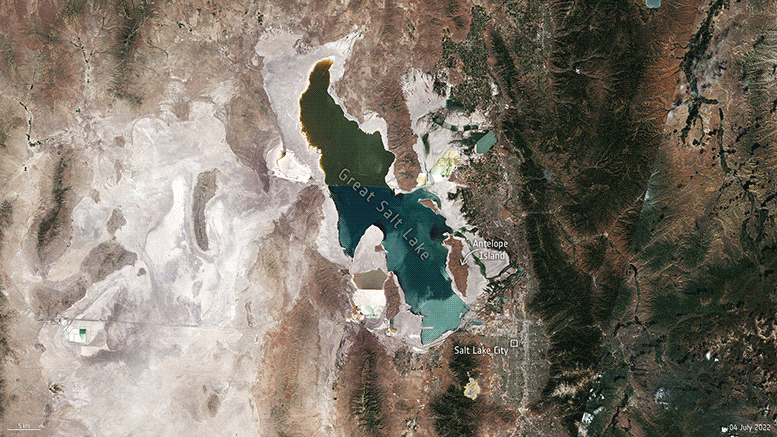Utah’s Great Salt Lake Is Disappearing – Megadrought Persists Across the US Southwest
Lake #Lake


As a megadrought persists across the US southwest, Utah’s Great Salt Lake dropped to its lowest recorded water level.
Utah’s Great Salt Lake dropped to its lowest recorded water level last month as a megadrought persists across the US southwest. This has forced the fast-growing city to curb its water use. From space, satellite images show how water levels have dramatically fallen from 1985 to 2022 – exposing large expanses of lakebed.
According to data from the US Geological Survey (USGS), the Great Salt Lake’s surface water elevation fell to the lowest level since records began in the mid-1800s, to an average of 1277 m (4,190 feet) above sea level. As a result of this drop in water level, the lake has lost nearly half of its surface area from the historical average, exposing around 2000 sq km (770 square miles) of lakebed – an area the same size as Tenerife.
Now the lake barely contains more than one-fourth of the volume of water that it did at its high point in 1987, according to the USGS. Two of the main reasons behind the lake’s decline are water usage and the climate change-fueled drought.
The lake goes through seasonal cycles of water loss and replenishment after rain and snow melt fills it back up. According to officials, the water evaporation and depletion exceed the amount of water entering the lake. The lake’s water levels are expected to further decrease until autumn or early winter, when incoming water equals or exceeds the evaporative losses.
The satellite images below reveal how water levels have fallen from 1985 (top) to 2022 (bottom), exposing large expanses of the lakebed.
]]>
Great Salt Lake 1985. Credit: USGS/contains modified Copernicus Sentinel data (2022), processed by ESA
Great Salt Lake 2022. Credit: USGS/contains modified Copernicus Sentinel data (2022), processed by ESA
The declining waters of the Great Salt Lake poses devastating consequences for the economy, ecology, and people of northern Utah. The lake generates snowpack, acts as a refuge for hundreds of migratory birds and other wildlife, and generates millions in economic development through mineral extraction and tourism.
The Great Salt Lake is the largest saltwater lake in the western hemisphere, and one of the most saline inland bodies of water in the world. As the lake shrinks, it becomes saltier which endangers flies and brine shrimp which millions of birds rely on for food.
Declining water levels also impacts the local air quality. As the bottom of the lake dries up and more lakebed is exposed, the dry soil leads to an increase of dust in the air. The dust is laced with copper, arsenic, and other dangerous heavy metals that have accumulated in the lake, much of it being residue from mining activity in the region.
These can, over time, pose a public health hazard when dust storms carry them into populated areas, causing damage when inhaled and exacerbating other respiratory illnesses.
The image below shows the average aerosol concentrations near the open areas of the lake bed produced using data from the Copernicus Sentinel-5P satellite from June 1 to July 15 2022.
This image shows the average aerosol concentrations near the open-areas of the lake bed produced using Copernicus Sentinel-5P data from 1 June to 15 July 2022. The exposed lake bed of the Great Salt Lake could impact public health in the long term. As the bottom of the lake dries up and more lakebed is exposed, the dry soil leads to an increase of dust in the air. The dust is laced with copper, arsenic and other dangerous heavy metals that have accumulated in the lake, much of it being residue from mining activity in the region. Credit: Contains modified Copernicus Sentinel data (2022), processed by ESA, CC BY-SA 3.0 IGO
Another factor contributing to the lake’s dropping water levels is the reduction in ways that the lake regains water. Water is re-directed from the streams that feed the lake each year to agriculture and nearby residential areas, meaning the lake cannot easily replace the water it loses via evaporation.
Increased water demand due to the growing number population of the metropolitan Salt Lake City is another reason behind the Great Salt Lake’s desertification. Utah is the fastest-growing state in the US and is projected to increase almost 50% by 2060.
The image below utilizes data from the World Settlement Footprint to highlight the urban expansion of Salt Lake City occurring between 1985 to 2019.
The population of Salt Lake City has grown by around 20% since the 1980s. Increased water demand due to the large number of inhabitants in the surrounding area is one of the reasons of the Great Salt Lake’s desertification. This image utilizes data from the World Settlement Footprint to highlight the urban expansion occurring between 1985 to 2019. The World Settlement Footprint is the world’s most comprehensive dataset on human settlement created to improve the understanding of current trends in global urbanization. The World Settlement Footprint is a joint project by ESA, the German Aerospace Center (DLR), in collaboration with the Google Earth Engine team. Credit: ESA (Contains data from the DLR World Settlement Footprint)
The World Settlement Footprint is the world’s most comprehensive dataset on human settlement created to improve the understanding of current trends in global urbanization. The World Settlement Footprint is a joint project by ESA, the German Aerospace Center (DLR), in collaboration with the Google Earth Engine team.



